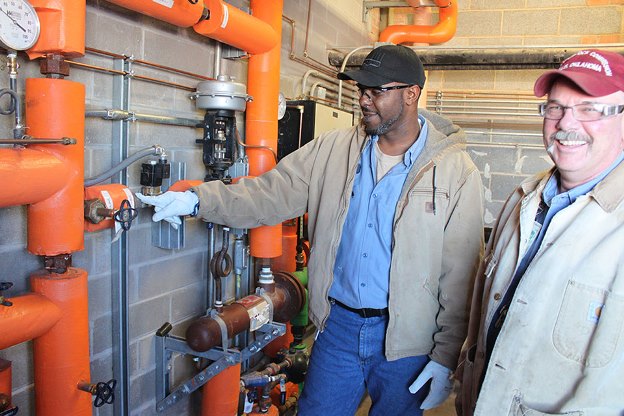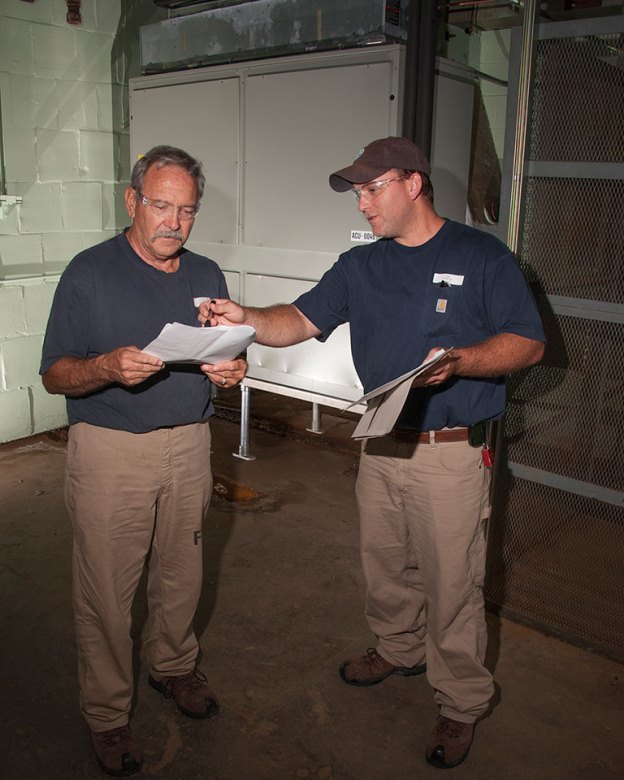Pantex Blog
CNS addresses employees’ benefits concerns
More than 400 Consolidated Nuclear Security (CNS) employees at Pantex met with vendor representatives last week during on-site consultation sessions to address issues, questions and concerns they were experiencing with the administration of their health care benefits.
Michelle Reichert, Pantex Site Manager, viewed the consultations as a step in the right direction, “Over the past two months, many of our employees have experienced issues with the administration of their health care plans, specifically prescription drugs, medical and dental plans – this is not acceptable,” she said. “Bringing the vendor representatives to Pantex for on-site, 30-minute, one-on-one sessions gave employees a confidential setting to ask questions, address issues, get information and learn how to make their benefits work for them.”
Future health care benefits consultation sessions are also being scheduled at Y-12.
CNS is also improving its health care benefits communications and advocacy for employees. In addition, CNS is forming an internally-focused working group to review current plans and evaluate whether adjustments can be made to the plans while still meeting Department of Energy contract requirements and the future implications of the Affordable Care Act.
While changes in benefits were and remain necessary under the CNS contract, employees at Pantex and Y-12 provided feedback that the challenges faced when using their benefits were not acceptable. As a result, CNS has increased efforts to actively work with its providers and demanding more from them to address health care benefits issues.
Women's History Month - Part 1
Since the days of World War II, women have played an important part in accomplishing the Pantex mission. While their loved ones fought on the battlefield front lines, they did their part on the Pantex assembly line.
Women dubbed the “80s Ladies” worked the Pantex assembly/disassembly line during the Cold War.
Today, hundreds of women engineers, scientists, technicians and professionals, including the first female Pantex site manager, help ensure the safety, security and effectiveness of the nation’s nuclear weapons stockpile.
In honor of Women’s History Month, we will look back at four historical articles about women at Pantex.
Part one of the series is an October 1942 article from the Pantexan, an employee newsletter.
Women on the Job
Capable hands will nurse the booster line into operation

Moselle McDaniels (left), Margaret Deal, Josephine Eubanks and Betty Solomon build boosters.
With the christening of the Booster line comes the advent of the use of women in actual production work at Pantex.
Every day more and more women are being employed in the nation’s war industries. Married women with husbands in Australia work beside girls with sweethearts in Ireland. Pantex Ordnance Plant is following the national trend of using women workers whenever possible. They will be the backbone of production in Zone 6, outnumbering the men about five to one.
Although the baby area in size, the Booster line has a man-sized job to do. Line Superintendent Frank L. Poeltler and his crew have shown in their preparations that they are capable of fulfilling that obligation.
The supervisory staff has spent much time in insuring the best of working conditions. All wearing apparel for both men and women is furnished and is serviced in the respective change houses. It is laundered regularly to insure cleanliness. Men wear the regular powder suits and shoes.
Careful consideration has been given to the problem of women’s working apparel, paying attention to the factors of comfort, safety and convenience. The outfit decided upon is a neat appearing combination of style and utility.
The women wear white cotton gabardine culottes, which button from neck to hem so that a skirt effect is produced when buttoned. These may be left only partly buttoned for more freedom.
A full cap with a jaunty bill which may be worn straight or tilted is the standard headwear. It is notable that no two of the women wear their caps alike.
White lisle stockings and two-toned powder shoes complete the visible ensemble. The same care was used in the selection of the unmentionables as was used for the rest of the outfit. It may be that the uniform will be changed to slacks and anklets later on, if found to be more practical.
In Booster building jobs requiring nimble fingers the women are more capable than men, and are equally competent in many other duties. There are several types of operations involved, from strictly manual to completely mechanical. The women have shown the greatest interest in operations involving a machine or mechanical “gadget,” and have shown greater aptitude than men in the use of micrometers and balances in the quality control operations.
Much false information has been spread, by persons unqualified to have opinions, about the dangers of this work. When the facts are explained by well-informed instructors, these fallacies are seen to be ungrounded.
Whatever dangers are inherent in this department, as well as in other departments, are well guarded against by safety regulations, which, if carefully followed, minimized the possibility of accident or illness.
Strict cleanliness is one of the safety regulations and makes for health, happy working conditions. The assembly rooms are kept cleaner than most parlors and are really quite pleasant.
Steam heat will be used to combat the “northers” which could be quite and Axis ally otherwise. Enclosed ramps and change house stairs will add their bit towards subjugating Old Man Winter.
All in all, the best conditions obtainable are being provided, so that no occupational accidents or illnesses can interfere with the women who are helping in building up Uncle Sam’s ammunition supplies.

Ernestine O’Brien uses a micrometer to ensure exactness in production.
Air Force Visitors Tour Pantex

Michelle Reichert, CNS Vice President and Pantex Site Manager (at left), and Jim Haynes, CNS President and Chief Executive Officer, welcome Deborah Lee James, Secretary of the Air Force, to the Pantex Plant.
Pantexans rolled out the red carpet last week for several Air Force visitors.
Deborah Lee James, Secretary of the Air Force, visited the Pantex Plant for a mission familiarization tour. She observed operations in several mission-vital facilities
Six personnel from Sheppard Air Force Base, near Wichita Falls, Texas, also visited the Plant last week. In addition to a Plant overview and history presentation, they toured facilities where Pantex production technicians build Joint Test Assemblies (JTA).
After the meticulous work on the JTAs is complete, the mock weapons are sent to the military for test flights. The valuable information gathered during these tests ensure the weapons function as designed and allows scientists and engineers at the national laboratories to validate the nuclear stockpile to the President of the United States.
CNS Infrastructure: Achieving a strong safety record

Pantex’s Shaun Ashley (left) and Kirk Spear identify lock out/tag out isolation points on a steam piping system prior to performing work.
Employees in Consolidated Nuclear Security’s Infrastructure organization have worked more than 3.2 million hours since a lost-time injury. For electricians, carpenters, machinists, riggers, welders and other craft personnel at the Pantex Plant and the Y-12 National Security Complex, the “office” is often atop a ladder or in a bucket truck working on high-voltage lines. That’s why working safely is a daily, if not hourly, preoccupation.
“It’s hard to pin down one or two things we’ve done to be successful,” said Scott Underwood, head of Y-12’s Infrastructure group with more than 900 employees who combined have worked more than 2.5 million hours without a lost-time injury. “We’ve leveraged all the people, processes and tools we have in place to make a difference.”
Foremost, explained Underwood, safety is not about a program; it’s about people. “You’ve got to care about your own personal safety and the safety of others. That’s where it starts,” he said. “We’ve also made improvements in some of our processes. When problems do arise, managers, front-line supervisors and craft personnel actively work together to find solutions.”

City of Oak Ridge employees and Y-12 Infrastructure and Environmental and Safety Programs workers gather for a pre-lift safety brief to repair a 24-inch water line on-site at Y-12. Though the recently completed project involved hazardous work, no injuries or negative events occurred.
Finding solutions is part of Steve Passmore’s job. “Every day, people call me and tell me their safety concerns,” said Passmore, one of the Atomic Trades and Labor Council’s safety officers assigned to Y‑12’s Infrastructure group. “We maintain a log, and we work the issues. If it’s a true safety issue, we find the money to get it fixed. However, some issues can be fixed without the need for additional funding. It’s just a matter of getting the right communication to the right people. Then I always get an answer back to those who call.”
Pantex Infrastructure manager Bob Asbury also knows a thing or two about closing the loop on safety suggestions, concerns and solutions. “It is critical that when issues are raised by employees they are welcomed by leadership, but more importantly the loop has to be closed with the employee,” he said. “You owe the employee an answer, and that is best delivered face to face.”
Asbury’s organization of about 375 employees has worked more than 330 days — more than 717,000 hours — without a lost-time injury. He attributes that track record to employee ownership of safety issues and solutions, supervisory engagement and an effective Plan of the Day, or POD. The POD, an electronic document prepared by Maintenance craft workers and management, serves as a daily risk-based review of work activities that then leads into a pre-job briefing.
Pantex’s Maintenance organization implemented the POD three years ago, and the idea has since caught on in other groups at the site. “The response has been truly amazing,” said Shane Feagan, Metal Trades Council safety officer at Pantex. “The POD now reaches people across many organizations at the plant. The most important thing the POD brings to the table is that it ensures we all receive timely and accurate information.”
The Pantex POD description, authored by Feagan, was selected as an Energy Facility Contractor’s Group best practice and is also featured on the Department of Energy’s OPEXSHARE website.
Taken together, the Y-12 and Pantex processes, tools and people undergird the CNS Infrastructure organization’s commitment to creating and maintaining a continuously improving safety culture.

Y-12’s Ron Sharp (left) and Josh Howard (both heating, ventilating, and air-conditioning, or HVAC, mechanics) look over a job package before performing work on an HVAC system. Behind both men is one of the newly installed heat pumps to reduce utility costs and increase reliability.
Volunteers Prep for Pantex Science Bowls
Pantexans and their friends are busy preparing for what some would call their favorite Pantex event.
More than 150 volunteers will serve as officials for the regional Science Bowls sponsored this month by Consolidated Nuclear Security, LLC (CNS).

Pantexans (from left) Kayla Mendoza, Gabriel Chacon, Howard Thompson and Nathan Escarcega prepare to “buzz in” during a mock Science Bowl round.
The volunteers are employees from the Pantex Plant and NNSA Production Office, as well as West Texas A&M University (WTAMU) faculty and Texas Tech University Health Sciences Center School of Pharmacy students. Even a few Pantex Plant retirees will be on hand as moderators, science judges, scorekeepers and timekeepers.

Students from the Texas Tech University Health Sciences Center School of Pharmacy learn the Science Bowl rules and practice during a mock round to prepare for the upcoming regional competitions.
Thirty-eight teams will test their skills in the Feb. 7 competition for middle school students. Thirty-one teams, some from as far away as Lubbock and Higgins, will face-off at the Feb. 21 high school competition.
As part of CNS’s commitment to education, it will donate $1,000 to the science programs of the winning schools. Winners also receive an all-expense paid trip to Washington, D.C. to compete in the U.S. Department of Energy’s National Science Bowl®.
